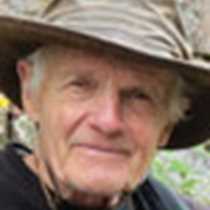A silvery dawn found us still peacefully anchored in Lowe Inlet. As the mist began to rise we divided into groups to go kayaking, exploring in an expedition landing craft, or hiking ashore. A large waterfall attracted every group’s attention, the landing craft going right up to the waterfall, and the kayaks tempting fate by going as close as they could through the boiling rapids. In the meantime hikers climbed up a steep rough trail with spring bursting out all over. Moss and lily of the valley covered the hillside, huckleberry leaves were opening up, and dwarf dogwood was struggling towards the sun. Huge Sitka spruce towered over the Western hemlocks, red cedar, and silver fir.
We passed a giant cedar tree which showed a scar where natives stripped off some bark for clothing and baskets many years ago. Naturalists warned everybody of the devil’s club, armed with horrid spines. This plant is the most important to natives of British Columbia for its reputed medicinal value for arthritis, ulcers, digestive track ailments, and diabetes. It is considered to be a highly powerful plant that can protect one against evil influences of all kinds!
We soon arrived at an opening where we could get a wonderful view of the falls. While it looked daunting we concluded that salmon must be able to make their way above the falls as below us on the nearby beach natives had arranged boulders in a shallow bay to trap salmon on a falling tide. Also, in the distance were the remains of another cannery.
In the afternoon Bristol Foster gave an introductory lecture on Haida Gwaii. There is now much anticipation among the guests.









